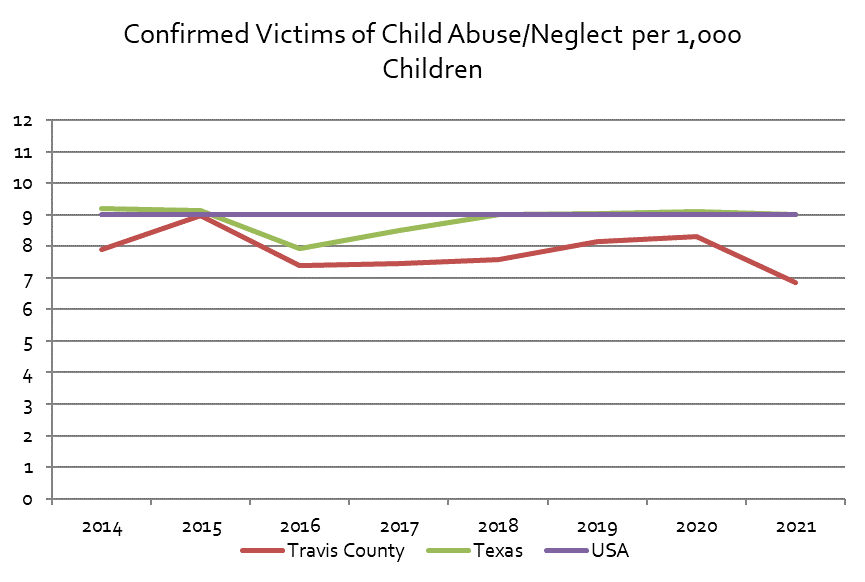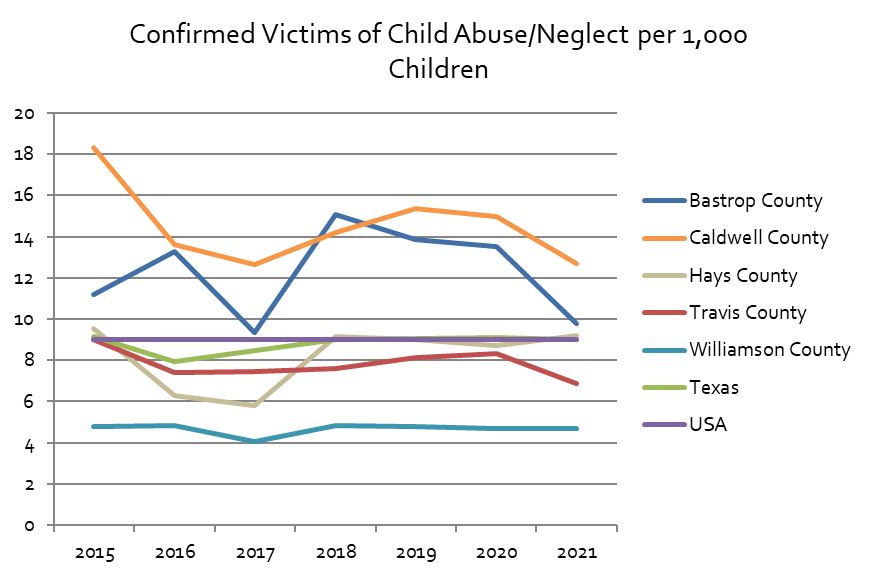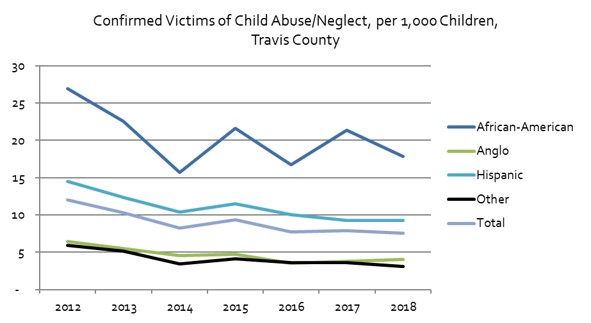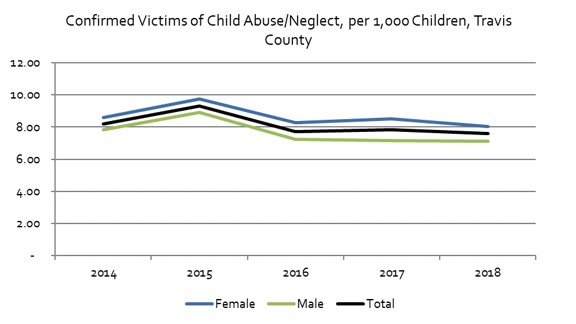Child Abuse and Neglect
Approximately 7 per 1,000 children under 18 experienced child abuse or neglect
Indicator: Rate of Children and Youth Confirmed as Experiencing Child Abuse or Neglect per 1,000 Children Under 18
Progress: In 2021, 6.85 children per 1,000 children under 18 experienced child abuse or neglect in Travis County
Significance of Indicator: Negative experiences early in childhood can have negative repercussion’s throughout a child’s life. According to the U.S. Department of Health and Human Services, Administration on Children and Families, “toxic stress”, including child abuse and neglect, has negative impacts on children’s brain development and can lead to poor physical and mental health outcomes later in life. Nationwide, the Center for Disease Control and Prevention estimates that the lifetime cost of one year of confirmed cases of child abuse/neglect reach $124 billion
what the data tell us

Definition: The number of children confirmed by child protective services as having experienced abuse or neglect, following an investigation, per 1,000 children under 18.
Data Source: Travis County and Texas data from Texas Department of Family and Protective Services Annual Data Book, national data from the Kids Count Data Center
Data Considerations: All data related to child abuse and neglect include only the number of cases known to authorities. The data, therefore, excludes cases of abuse and neglect which are not reported to state authorities. Figures represent the number of children confirmed to have experienced abuse or neglect in a given fiscal year (September through August), rather than the number of instances of abuse and neglect. One child may experience more than one incident of abuse or neglect. National data are aggregated from a variety of state protective service agencies. Definitions and reporting standards may vary from state-to-state. Therefore, the national figure may not be directly comparable to state and county data.
The story behind the data
The rate of children who have experienced abuse or neglect per 100,000 children in Travis County experienced a general decline from 2016 to 2021 after remaining relatively stable from 2013 to 2015. Rates of confirmed cases of abuse and neglect were higher for African-American children than children of other races and ethnicities in 2021, although this disparity appears to have decreased over time. It is important to note that this figure only includes cases of child abuse and neglect that have been reported. Many cases may go unreported and are therefore excluded from this definition. Greater awareness and reporting may lead to increased rates of confirmed instances of abuse and neglect.
Across the five-county Austin Metro Area, Travis, and Williamson Counties appear to experience lower rates of child abuse and neglect than the state, whereas children in Bastrop and Hays Counties were slightly more likely to experience abuse and neglect, while the rate for Caldwell County was significantly higher than the state.
The story behind the data
In 2021, a lower share of children in Hays, Travis, and Williamson Counties experienced child abuse and neglect than the state as a whole. Children in Bastrop and Caldwell Counties were slightly more likely to experience child abuse and neglect than Texas children as a whole. Of note, the rate in Caldwell was 12.68 confirmed victims per 1,000 children was over 40% higher than the rate for the state of Texas, while the share of children identified as experiencing abuse and neglect in Bastrop and Hays Counties appeared to be slightly higher than the State or USA.

Definition: The number of children confirmed by child protective services as having experienced abuse or neglect, following an investigation, per 1,000 children under 18.
Data Source: Travis County and Texas data from Texas Department of Family and Protective Services Annual Data Book, national data from the Kids Count Data Center
Data Considerations: All data related to child abuse and neglect include only the number of cases known to authorities. The data, therefore, excludes cases of abuse and neglect which are not reported to state authorities. Figures represent the number of children confirmed to have experienced abuse or neglect in a given fiscal year (September through August), rather than the number of instances of abuse and neglect. One child may experience more than one incident of abuse or neglect. National data are aggregated from a variety of state protective service agencies. Definitions and reporting standards may vary from state-to-state. Therefore, the national figure may not be directly comparable to state and county data.
Child Abuse and Neglect, by Race and Ethnicity, Travis County
African-American children are more likely than children of other races and ethnicities to experience child abuse or neglect, although this disparity has declined since 2012. In 2018, 18 African-American children per 1,000 children experienced abuse or neglect, compared to 4 Anglo children per 1,000, 9 Hispanic children per 1,000, and 3 children of another race per 1,000 (Since 2014, not enough Native American children were identified as having experienced abuse or neglect in Travis County to calculate a reliable rate). A majority of children confirmed as victims of abuse or neglect are Hispanic (56% of victims of child abuse or neglect), although Hispanic children make up the largest share of the child population as well (51%, according to DFPS estimates).

Definition: The number of children confirmed by child protective services as having experienced abuse or neglect, following an investigation, per 1,000 children under 18, by race and ethnicity
Data Source: Travis County and Texas data from Texas Department of Family and Protective Services Annual Data Book
Data Considerations: All data related to child abuse and neglect include only the number of cases known to authorities. The data, therefore, excludes cases of abuse and neglect which are not reported to state authorities. Figures represent the number of children confirmed to have experienced abuse or neglect in a given fiscal year (September through August), rather than the number of instances of abuse and neglect. One child may experience more than one incident of abuse or neglect. Population estimates by race and ethnicity are produced by the Texas State Data Center and reported by Texas DFPS. Due to changes in data reporting, data prior to 2012 are not comparable to data reported for 2012 and after.
Child Abuse and Neglect, by Sex, Travis County
Female children are more likely than children of other races and ethnicities to experience child abuse or neglect. In 2018, 8 female children per 1,000 children experienced abuse or neglect, compared to 7 male children per 1,000, and 8 children of all sexes per 1,000. A majority of children confirmed as victims of abuse or neglect are female (52% of victims of child abuse or neglect), while female children make up the smallest share of the child population (49%, according to DFPS estimates).

Definition: The number of children confirmed by child protective services as having experienced abuse or neglect, following an investigation, per 1,000 children under 18, by sex
Data Source: Travis County and Texas data from Texas Department of Family and Protective Services Annual Data Book
Data Considerations: All data related to child abuse and neglect include only the number of cases known to authorities. The data, therefore, excludes cases of abuse and neglect which are not reported to state authorities. Figures represent the number of children confirmed to have experienced abuse or neglect in a given fiscal year (September through August), rather than the number of instances of abuse and neglect. One child may experience more than one incident of abuse or neglect. Population estimates by race and ethnicity are produced by the Texas State Data Center and reported by Texas DFPS. Due to changes in data reporting, data prior to 2012 are not comparable to data reported for 2012 and after.
some local efforts to improve this indicator
Child Protective Services
Child Protective Services (CPS) is housed within the Department of Family and Protective Services. CPS is charged with investigated reports of abuse and neglect of children; providing services to children and families in their own homes and placing children in foster care when appropriate. The goal of CPS is to promote the safety, permanency, and well-being of children. Thus, CPS investigates cases of child maltreatment and seeks to keep children safe while maintaining ties to their families and communities as much as possible. It is important to note that CPS investigates cases of child abuse and neglect that occur by members of the child’s household or cases when the child is not being protected from abuse by their caregivers. When abuse occurs by someone outside the family, local law enforcement investigates suspected maltreatment. To learn more about CPS, visit: www.dfps.state.tx.us/child_protection/
Mandatory reporting
Texas law says anyone who thinks a child is being abused, neglected, or exploited must report it to CPS. A person who reports abuse in good faith is immune from civil or criminal liability. CPS keeps the name of the person making the report confidential. Anyone who does not report suspected abuse can be held liable for a misdemeanor or felony. Time frames for investigating reports are based on the severity of the allegations. Reporting suspected abuse makes it possible for a family to get help. To report suspected child abuse, call 1-800-252-5400 or visit txabusehotline.org
Local law enforcement
Austin Police Department assigns detectives in the Child Abuse Unit to investigate specific matters of Online Solicitation of a Child, Criminal Solicitation of a Child, Child Pornography, and Displaying Material Harmful to a Minor. They investigate incidents that spawn from Internet chat rooms, cellular telephones, blog pages, online forums, video games, and other media and other communications formats. The unit is responsible for investigating all criminal cases of physical abuse and neglect of children 14 years of age or younger and sexual abuse of children younger than 17 years of age, occurring in the City of Austin. Non-emergency reports can be filed by calling 3-1-1. For more information, visit: austintexas.gov/department/child-abuse
Center for Child Protection
The Center for Child Protection, a nationally accredited children’s advocacy center, is the first stop for children in Travis County who are suspected victims of sexual abuse, physical abuse, neglect and for children who have witnessed a violent crime. The Center is a child-friendly, specially-equipped facility where children go for recorded forensic interviews, medical exams, counseling and intervention during the investigation and prosecution of child abuse cases. It is the only non-profit in Travis County involved in the investigation of crimes against children. All services are provided to children and their protective caregivers at no charge and most are available in English and Spanish. For more information, call (512) 472-1164 or visit: www.centerforchildprotection.org/
Citizen Review Teams
Citizen review teams are volunteer citizen-based panels established by the Texas Department of Family and Protective Services (DFPS) to evaluate department casework and decision-making related to services to children and families who experience child abuse/neglect. Membership includes community representatives and private citizens residing in the area for which the team is established. Teams meet regularly to review investigations and ongoing intervention conducted by CPS caseworkers. The reports that the teams compile are used by DFPS to improve services and casework practice, and to provide accountability for federal funding.
Child Fatality Review Teams (CFRTs)
CFRTs are multidisciplinary, multiagency working groups that review child deaths on a local level from a public health perspective. By reviewing circumstances surrounding child deaths, teams identify prevention strategies that will decrease the incidence of preventable child deaths. Members include law enforcement, prosecutors, medical examiners, justices of the peace, health-care professionals, educators and child advocates. These teams are uniquely qualified to understand what no single agency or group working alone can: how and why children are dying in their communities. By sharing information, team members discover the circumstances surrounding a child’s death. In 1992, DFPS began its support of Child Fatality Review Teams through a grant from the Children’s Justice Act. That same year, the state’s first team was formed in Dallas.
Trauma-Informed Care Consortium of Central Texas
The Trauma-Informed Care Consortium of Central Texas brings together stakeholders from a number of local organizations to create systems that support children and families who have experienced traumas. The Consortium works to create a trauma-informed community by providing training, outreach, and education to professionals and community members.
Contributors:
Dr. Monica Faulkner, Child and Family Research Institute at the School of Social Work at the University of Texas at Austin contributed to the development of this page.
2018 © Ready by 21 Austin
Ready by 21 (RB21) and the RB21 logo are registered trademarks of the Forum for Youth Investment. The Central Texas RB21 Coalition is a member of the Forum’s RB21 Learning Network. The Central Texas RB21 online dashboard is currently sponsored by Workforce Solutions — Capital Area Workforce Board, the Community Advancement Network (CAN) and the City of Austin, with content and data contributions from over 20 local youth-serving coalitions.
disproportionately impacted
The American Psychological Association states there are numerous risk factors, which in combination with each other, raise the probability of a student dropping out of high school:
- Individual Risk Factors (e.g. truancy, poor school attitude, etc.)
- Family Risk Factors (e.g. low-income, lack of parental involvement, etc.)
- School Risk Factors (e.g. negative school climate, low expectations, etc.)
- Community Risk Factors (e.g. high crime, lack of community support for schools, etc.)
According to the E3 Alliance, students who were retained in 9th grade, students who were frequently absent, and students who moved or changed schools frequently were less likely to graduate in four years than other students.
